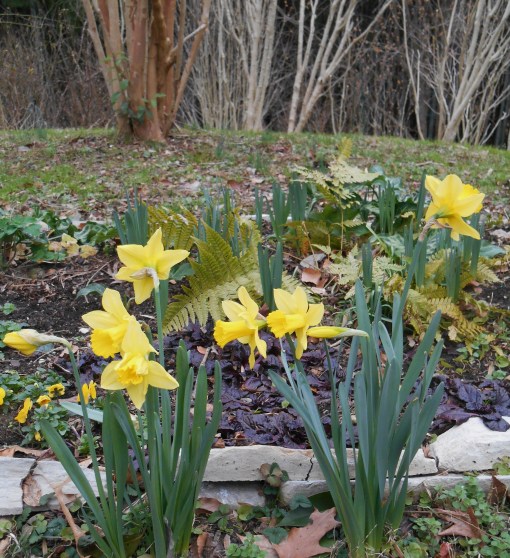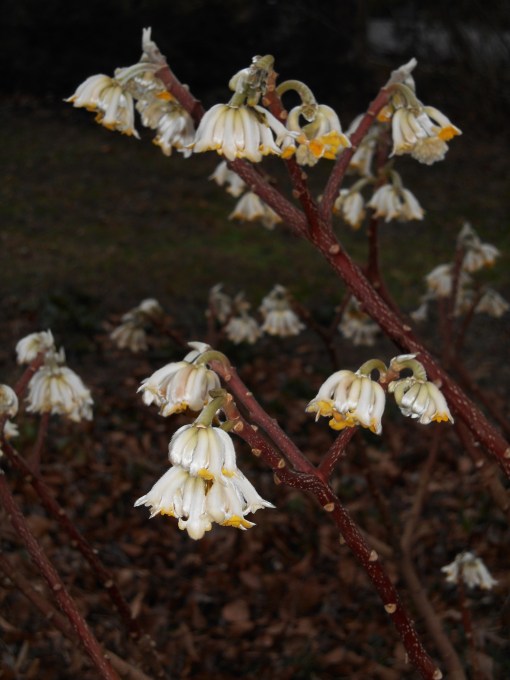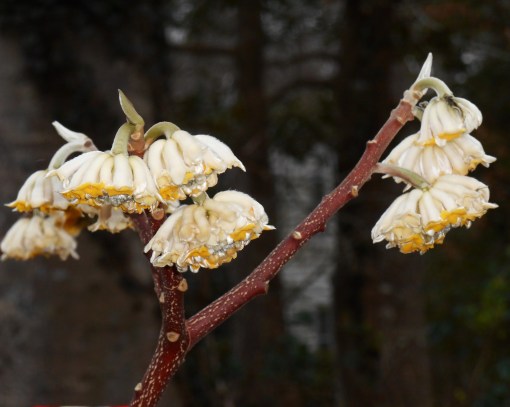
~
Lunch, right? Maybe not….
I read an interesting tip last night about planting carrots in the April 2017 issue of Fine Gardening Magazine .
~

~
Most of us immediately think of seeds and planting carrots in our vegetable garden to harvest and eat in a few months. This writer, David Perry of Seattle, explains how he plants “ratty carrots from the local produce stand” at strategic places in his flower garden.
Since carrots are biennials, in their first year they put their energy into growing a fat, orange tap root. But while that is happening, beautiful fern-like leaves fuel the delicious growth. This is the point where most of us pull the carrot, discard its foliage, and transform it into something delicious and satisfying.
But wait, there’s more!
~

~
Perhaps, like me, you’ve set a severed carrot top into a shallow dish of water to amuse a child. What is left of the tap root will continue to drink, and new leaves will sprout.
The carrot leaves will grow, in a bright windowsill, for a few weeks until bacteria wins the day and you feed the project to your compost pile. I’ve been known to amuse myself in this way through a particularly raw February! It feels like a little horticultural miracle unfolding in the dead of winter.
~

Parsnips
~
But David goes a step beyond this to create something lasting and beautiful. He takes a carrot, already pulled and trimmed and destined for the table, and gives it a reprieve in his garden. Like a pardoned turkey at Thanksgiving, this joyous root rewards him with beautiful flowers and foliage for the season.
He says, “Visiting gardeners and garden designers often ask about the white umbels that appear at beautiful strategic places in my garden. Here’s my secret: ….”
This is certainly an economical way to generate large, flowering, unusual plants. David simply plants a carrot or two wherever he wants to enjoy their flowers later in the season.
To do this, choose a carrot which still has its top where leaves can grow. Dig a narrow hole an inch or two deeper than your carrot is long. You can just open the earth with a shovel or trowel to the necessary depth, slip the carrot in so the top sits flush with the top of the soil, and push the hole closed around the carrot.
Site your carrots in part or full sun, in good soil, and keep the root moist as it begins to grow again and gets established. You may need to stake the plants as they grow, especially if you’ve planted in rich soil. They will grow to several feet high.
~

Queen’s Anne’s lace, or wild carrot
~
Do you know the wildflower, “Queen Anne’s Lace?” These beautiful creamy white flowers turn up on Virginia roadsides and along the edges of fields each summer. I’ve always admired them, and they provide a rich food source for pollinators.
Queen Anne’s Lace, Daucus carota, is also known as ‘Wild Carrot.” This may give you an idea of what to expect from planting a carrot in your garden! And while wild Daucus carota is generally considered poisonous and not gathered for food; true carrot leaves, from the edible Daucus carota subspecies sativus can be eaten. In other words, the foliage from edible carrots in either their first year of growth, or their second, may be harvested and added to your salad.
~

Horseradish and parsley roots
~
Like many leaf vegetables, they contain alkaloids. But they also contain many healthful vitamins and minerals. There are some yummy carrot recipes and a full discussion of their nutrition here.
In years passed, before the convenience of packaged seeds; many gardeners left a few carrots in their garden over winter to flower and produce seeds in their second year. Seeds from the previous year’s crop of carrots were gathered and saved every fall so there were always seeds to plant the following spring.
~

Taro is also Colocasia. Plant these when the soil is warm, and huge ‘Elephant Ears’ will soon emerge.
~
This also works for parsley, fennel, broccoli, celery, onions, garlic, and many other vegetables and herbs. In fact, the flowers from all of these add to the beauty of an herb or flower garden.
Their flowers attract beneficial insects, like lacewings and lady bugs who help eradicate harmful ones. Beneficial insects are always welcome in organic gardens and wildlife gardens were pesticides aren’t used.
~

Garlic chives, and similar flowers attract beneficial insects to your garden. Beneficial insects help control harmful ones, and pollinators increase yields.
~
And so, if against all odds, you replant that carrot rather than eating it; you’ll reap a rich harvest of flowers, food, and other benefits in your garden. Since carrots are biennials, each carrot you plant will give flowers over a single summer. The flowers will eventually yield seeds, and then the entire plant will die back. The carrot you planted will no longer be edible, after this second year of growth.
But carrots aren’t the only produce market find you can plant and enjoy. Try parsnips, another biennial, as well.
~

Clockwise, from lower right: Garlic, Tumeric root, Jerusalem artichoke, carrot and ginger root. Jerusalem artichoke, Helianthus tuberosus, produces very tall yellow flowers in summer, like small sunflowers, and edible tubers.
~
Ginger and tumeric, tropical and tasty rhizomes, will root and grow beautiful foliage in a pot or garden bed. You can’t leave them outside over winter in our climate, but they will add to the garden’s beauty while the rhizomes grow larger over the season, and can be saved indoors from year to year.
Heads of garlic may be broken into individual cloves and planted in rich garden soil in full sun in autumn. Each clove will grow into a new head of garlic the following summer. Garlic and garlic chives also produces beneficial flowers.
~

~
Go ahead and plant a piece of that horseradish root in your garden to produce more. These grow into large plants, so you need to leave a few feet in all directions for it to grow. Horseradish is a perennial and is grown from root cuttings, not seed.
Green onion roots may be planted even if you’ve sliced and diced their tops onto your dinner. Often hydroponic lettuce heads come with roots still attached. Harvest some of the leaves and plant the roots and crown.
~
 ~
~
Potatoes may be cut into chunks, each with an eye, and replanted to grow a new potato vine. Many gardeners recommend buying certified seed potatoes to avoid spreading certain potato diseases, but in a pinch….
Buy a sweet potato now, and coax it into growth in a shallow pan of moist soil or even suspended in a jar of water. New green shoots will soon begin to grow.
These luscious vines may be grown for their own sake. They are both beautiful and edible. But if you break the starts away from the potato when the soil has warmed in May, each may be planted out in the garden (or a pot) to grow into a new, productive, sweet potato plant. You can produce a garden full of sweet potatoes from the shoots of a single ‘mother’ potato.
~

~
Some markets offer prickly pear cactus pads. Each may be rooted and grown in full sun to a prodigious size over the years. Your new plant will begin producing fruit in just a few years. You might also plant the seed in your avocado to grow your own tree.
Beautiful pineapple plants may be grown from the crown of a fruit. I even have a potted grapefruit tree which grew from a sprouted seed I found in my Ruby Red one day!
It is easy to save seeds from pumpkins and winter squash to plant the following spring. Even raw peanuts are seeds, remember, and each will grow into a productive peanut plant!
Against all odds, you can create a beautiful and productive garden from what might otherwise be eaten or thrown away.
~

~
This week, I’ve been reading Ken Druse’s book, Making More Plants. 
What a wonderful read in February! Druse explains, in well-illustrated detail, how to grow new plants from stems, seeds, leaves and roots. Whatever you might be lacking in propagation skills, you will find guidance and ideas to create new plants for your garden from the tiniest bit of leaf or root. He shows how to build or find the equipment you need, explains the botany, and demonstrates how to become more successful at multiplying your plants.
~
Relax, daydream a bit, and notice what might have a second life if given a chance. Consider how to use all of the resources at hand….
This is how our ancestors supported themselves and their families in the days before supermarkets and garden centers.
There is always more to discover and to learn…..
~
 ~
~
Woodland Gnome 2017
~

Wild carrot flowers
~
for the Daily Post’s
And with appreciation to our local Harris Teeter for allowing me to take photos in their produce department.




















 ~
~


 ~
~

 ~
~





 ~
~















